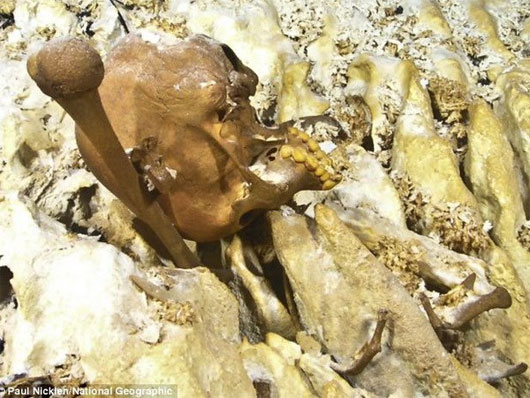The oldest remains reveal the Native American origin in the Americas
An international team of researchers confirmed the discovery of an almost complete skeleton of a prehistoric girl found in an underwater cave in Mexico.
The discovery could help answer questions surrounding the origins of the first people who arrived in the Americas.
In an article published in the American journal Science on May 15, researchers from the Mexican Institute of Anthropology and National History and the National Geographic Society reported having found the skeleton. of a girl about 15-16 years old named them "Naia" , meaning "Water Goddess" in Greek, 7 years ago.
The remains are located in a cave 42 meters deep underwater at the Yucatan Peninsula, eastern Mexico. Here, scientists also found many skeletons of at least 26 large animals, including the sword tigers and a giant sloth.

Part of the skeleton was discovered.(Photo: National Geographic)
Scientists are more likely to have fallen into this cave and died "almost immediately" due to the pelvic fracture after a strong impact.
Based on the analysis of tooth enamel and minerals found on Naia's bones, the researchers determined she lived 12,000 to 13,000 years ago. At that time, the cave was a barren land, but then the melting continental ice sheets made the sea level rise and turned it into a deep cave from 9,700 to 10,200 years ago.
Through analysis of Naia's remains , the researchers also discovered her skull and face possessing similarities to the faces of the first Indian Indians such as small faces and narrow, big eyes, rough forehead and teeth that protrude out. This is markedly different from the Aboriginal people today who have a broader, more rounded skull.
Scientists most likely identified Naia as originating from people migrating from Northeast Asia from 18,000 to 26,000 years ago. These people crossed the Bering Strait to set foot on the Bering Land Bridge , also known as Beringia , which emerged between Siberia and North America.
This finding contradicts previous assumptions that the ancestors of Native Americans came from Europe, Southeast Asia and Oceania.
In the future, scientists will continue to study nuclear DNA samples (mixed genetic structures from both parents) in the skeleton to identify and clarify Naia's true ancestors.
- Discover the oldest DNA man in North America
- Mexico studied 30 sets of ancient remains
- The 3,200-year-old remains have cancer
- Discover the oldest set of British Royal remains
- Detecting the remains of cancer patients 4,500 years ago
- 11,500-year-old baby girl revealed human origins in North America
- History of dogs and American civilization
- 9,000-year-old remains reveal the collapse of the old city
- Genetic studies reveal the origin of the placenta
- Ancient remains reveal our 'fishman' ancestors
- Close-up of the world's cutest wild cats
- Discover the world's oldest nuclear family remains
 Discovered an ancient centipede fossil 99 million years old
Discovered an ancient centipede fossil 99 million years old Discovered bat-like dinosaurs in China
Discovered bat-like dinosaurs in China Discovered a 200-year-old bronze cannon of the coast
Discovered a 200-year-old bronze cannon of the coast Discover 305 million-year-old spider fossils
Discover 305 million-year-old spider fossils